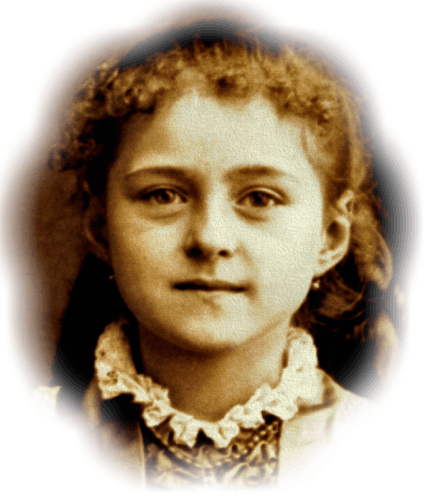
BIOGRAPHY
Page 2, Her Childhood
Early Childhood [1837-1877]
Of farming and army stock, the Martin family had solid roots in Normandy and Mayenne. Brought up in a series of military camps, Louis Martin thought of seriously of entering a monastery. But this was not to be, and he turned to clock and watch-making instead. Zélie Guérin was also unsuccessful in her attempt to enter the religious order of the sisters of the Hôtel-Dieu. Thérèse's Mama to be learned the Alençon lace-making technique and soon mastered this painstaking craft. They married in 1858 but determined they would be celibate until a priest told them that was not how God wanted their marriage to work. They must have followed his advice very well because they had nine children. Four, including two boys, died in infancy. The five children who lived were all daughters who were close to each other all their lives. Thérèse, the youngest, was born on January 2, 1873. She was put out to nurse for a year and became a lively, mischievous, and self-confident child; she thrived on the love that surrounded her in this pious Catholic household, where prayer, the liturgy, and practical good works formed the basis of her own ardent love of Jesus—her desire to please him and the Virgin Mary. But sorrow struck early in her life when her mother died of breast cancer in the summer of 1877. Thérèse was four and a half years old. Her sixteen-year-old sister, Pauline, became her second mother.
Lisieux—LES
BUISSONNETS 
Her father was left to
raise the five girls, ranging from four to seventeen. His
brother-in-law, Isidore Guérin, a chemist in Lisieux, invited
them all to go and live with him in this small town, with its
population of just 18,600 people. They moved on 15 November 1877.
Thérèse spent eleven years at Les Buissonnets, a fine
house with a quiet garden, some way from the center of the town. Her
sisters, Marie and Pauline, took care of her education. "Poor
Léonie" was a difficult child.
Céline, nearly four years older, was her favorite playmate. Louis Martin was both father and mother to his children. He called Thérèse his "little queen" and often took her walking or fishing in the surrounding countryside. The shock of her mother's death had changed her from a lively, self-confident child into an introverted, shy and self-effacing one. Her entry into the Benedictine Abbey School of Notre-Dame du Pré was a trial for her: "The five years [1881-1886] I spent there were the saddest of my life." She worked hard, and loved catechism, history and science, but had trouble with spelling and mathematics.
At the age of ten, she was deeply distressed when Pauline, her favorite sister whom she had chosen as a substitute mother, left to become a Carmelite in October of 1882. This new emotional shock went so deep that she fell seriously ill with a fever and people thought she was dying. For a whole month, her family were at their wits' end; even doctors could find no explanation for the hallucinations, tossings, turnings and anorexia that afflicted her. The worst part of it for Thérèse was all the people sitting around her bed staring at her like, she said, "a string of onions." Family and Carmelites alike prayed to Our Lady of Victory. When Thérèse saw her sisters praying to a statue of Mary in her room, Thérèse also prayed. And, on May 13, 1883, when it seemed that she would either die or lose her sanity, she saw the family's statue of the Virgin smile at her, and she was cured. She tried to keep the grace of the cure secret but people found out and badgered her with questions about what Mary was wearing, what she looked like. When she refused to give in to their curiosity, they passed the story that she had made the whole thing up.
Without realizing it, by the time she was eleven years old Thérèse had developed the habit of mental prayer. She would find a place between her bed and the wall and in that solitude think about God, life, eternity.VIEW THE BORDER IMAGE PLAIN
 Contact Us
Contact Us
HOME--------------------------SAINTS
www.catholictradition.org/Lisieux/therese1-2.htm